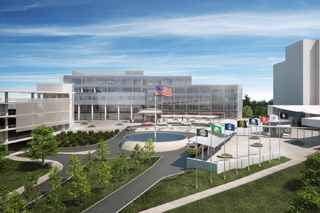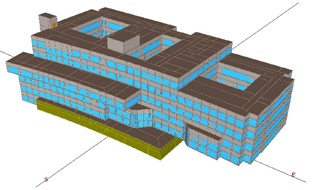|
Subscribe / Renew |
|
|
Contact Us |
|
| ► Subscribe to our Free Weekly Newsletter | |
| home | Welcome, sign in or click here to subscribe. | login |
Construction
| |
 |
June 23, 2011
New VA complex to treat ‘emerging’ war injuries
Stantec Consulting

Smith
|
Today’s combat veterans are experiencing new types of injuries and post-war conditions.
Post-traumatic stress disorder, Gulf War syndrome, and soft-tissue injuries from improvised explosive devices (IEDs), or roadside bombs, are examples of conditions that are challenging conventional veteran health care approaches. Just as the needs of the patients and practitioners continue to evolve, so do the designs for treatment facilities.
The U.S. Department of Veterans Affairs is developing a new mental health and research complex at its campus on Beacon Hill. It will be a key facility in a new nationwide VA program that provides state-of-the-art service to 21st-century war-injured veterans and conducts advanced research on new diagnostics and cures for these emerging types of injuries.
The Seattle project involves a new six-story, 210,000-square-foot building, 1,000 parking stalls, and central plant and utility tunnel improvements. An adjacent nursing tower will receive seismic upgrades.
Centralized care
Soldiers aren’t the only ones who sustain war-type injuries anymore. Civilians get them also, as evidenced by the 1995 Oklahoma City federal building bombing, the 1996 Centennial Olympic Park bombing in Atlanta, and the 2001 attacks on the World Trade Center.
Health care facilities here and abroad are increasingly prepared to see IED victims suffering from burns, head trauma, bone fractures, eye and ear damage, blunt force or shrapnel injuries, and pulmonary injuries from the air pressure differences.
Additionally, treating war-related trauma, especially blast victims, continues to grow in complexity with the evolution of diseases and infections caused by absorption of dirt or infectious material. For example, a suicide bomber may have HIV and infect survivors near him in the blast should they sustain penetrating injuries, or a victim may have been rolled through the dirt in the blast after sustaining lacerations.
| VA mental health and research complex |
|
U.S. Department of Veterans Affairs, Washington, D.C. Prime architect: Stantec Architecture, San Francisco Associate architect: The Design Partnership, San Francisco Structural engineer: Degenkolb Engineers, Seattle Mechanical/sustainability consultant: Stantec Consulting, Seattle Electrical engineer: Sparling, Seattle Civil engineer: Coughlin Porter Lundeen, Seattle Landscape architect: Nakano Associates, Seattle Geotechnical engineer: GeoEngineers, Redmond Cost estimator: Davis Langdon, Seattle Lab planner: RFD, San Diego |
Treatment for these kinds of injuries sometimes requires patients to travel for miles for lab tests, X-rays, CT scans and other diagnostic services. Symptoms are sometimes psychological, requiring yet another kind of treatment service.
The design of the new Seattle facility centralizes variable diagnosis, treatment and research services in one location that will benefit both veterans and civilians, saving time, money and lives.
Efficient systems
The new facility will not only be patient friendly but also environmentally friendly.
In addition to its service capabilities — diagnostic labs, clinical labs, exam rooms, staff offices and group therapy rooms — the design also includes green roofs, two outdoor landscaped courtyards and an atrium-style therapeutic courtyard. Natural daylight and views of nature are incorporated throughout to help patients recuperate more quickly and to provide a high-productivity work environment for staff.
The hospital expects the project to receive a LEED silver rating as well as 30 percent energy savings and lower utility bills.
Stantec’s sustainable design approach optimizes the overall project outcome to achieve the owner’s project requirements, delivering projects faster, better and cheaper than the traditional linear design approach.
For example, energy modeling is used to determine the building’s optimal shape, orientation and window sizes and locations. Such modeling reduces the building’s direct solar gain, resulting in less demand for air conditioning. With smaller HVAC equipment, the owner can cut construction, operation and maintenance costs. Patients, staff and visitors, too, will be more comfortable and get better natural light.
High-performance systems contribute to the economical functionality of the facility, supported by innovative mechanical, electrical and plumbing (MEP) infrastructure, including both ground-up and roof-down mechanical distribution systems, reducing the size of vertical shafts and ceiling plenum height for optimal net-usable-to-gross building floor-area ratio and reduced building height.
Emergency power
In the event of a natural or man-made disaster, the VA facility will be able to sustain itself for three days while providing emergency assistance. The building will have a standalone or off-grid utility services support system that includes power, water, fire protection, wastewater, and heating and cooling services.
Active chilled-beam HVAC technology combines a high-performance building envelope with high-efficiency lighting for improved indoor-air quality and temperature control, reducing both construction costs and operation and maintenance costs.
Active chilled beams offer all the benefits of traditional variable air volume and four-pipe fan coil unit systems with none of the usual drawbacks, such as wasteful “reheat” (where air is cooled by large central air handling units, then “reheated” locally for individual space temperature control), and costly forced air handling equipment and associated large ductwork.
Active chilled beams located in each occupied space use a small amount of ventilation air to provide a large amount of heating and cooling by use of small heating and cooling water coils inside each chilled beam. It is far more economical to move heat by water than by the traditional “forced air” approach.
Active chilled beams strike a balance between traditional forced-air heating and cooling systems versus newer pure radiant technologies.
Patient considerations
Patient comfort and security were foremost of all the project design considerations. Patients suffering from PTSD, Gulf War syndrome or a number of other mental health conditions may be in an agitated or anxious state.
The facility layout is designed with continuous wayfinding throughout so that there are no dead ends where staff or an upset patient might find themselves feeling “trapped.” The lobby is an open space design, discouraging congestion and allowing patients to flow to other areas of the facility and exit without having to double back. Other design elements promote an aura of respect and tranquility, observing the needs of veterans.
Whether sustained from war or civilian tragedy, the prognosis for recovery of injuries incurred in these modern times is greatly improved with the help of efficient and leading-edge facilities like the VA Seattle mental health and research facility.
Doug Smith is the lead mechanical engineer and sustainability consultant for the VA Seattle mental health and research project. Stantec provides full A/E design services for the North American vertical construction market, including health care facilities.
Other Stories:
- 13 tips for choosing your medical space
- Study will help UW’s Montlake Tower cut energy costs
- Swedish Issaquah aligns design with patient needs
- Good signage points the way to better health care
- 'Novel' process lets Swedish Issaquah hit fast forward
- ‘Hybrid’ rooms a low-cost answer to space needs
- Swedish women’s cancer center a one-stop shop
- Group Health is designing its clinic of the future
- Puyallup hospital tower puts focus on patients
- Evergreen opens center closer to its patients
- Friday Harbor hospital aims to be nation’s greenest
- UW expansion stays on track despite big change in plans




